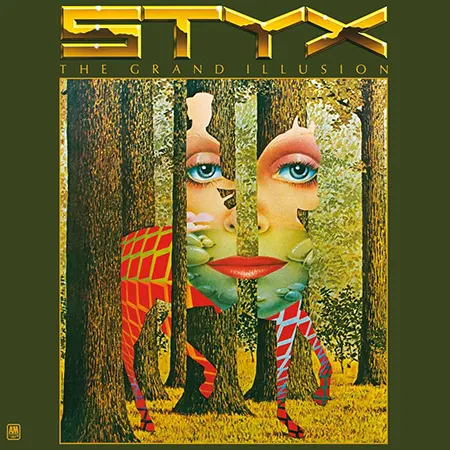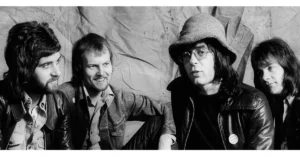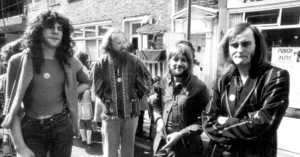Styx: Masters of Melodic Rock and Progressive Drama
Styx. Origins and Formation (Early 1970s)
Styx, formed in Chicago, Illinois in 1972, evolved from an earlier band called TW4, founded by Dennis DeYoung and twin brothers Chuck and John Panozzo. With the addition of guitarists James “J.Y.” Young and later Tommy Shaw, the group transformed into one of the most unique voices in American rock. Combining theatrical elements, powerful harmonies, and a fusion of progressive rock, hard rock, and pop, Styx quickly found their niche.

Their name, taken from the mythical river in Greek mythology that separates the living from the dead, perfectly reflects the band’s flair for drama and grandiosity.
Styx. Breakthrough and Classic Era (1975–1983)
Styx’s early albums explored progressive and classical rock themes. However, they truly broke into the mainstream with Equinox (1975), featuring the radio hit “Lorelei.” But it was with the arrival of Tommy Shaw in 1976 and the release of The Grand Illusion (1977) that Styx achieved major success.
Styx. Key Albums and Songs:
- The Grand Illusion (1977): Featuring the anthem “Come Sail Away”, it blended synthesizers and power balladry with philosophical lyrics.
- Pieces of Eight (1978): A harder-edged album with hits like “Renegade” and “Blue Collar Man.”
- Cornerstone (1979): Marked by the band’s only #1 hit, the ballad “Babe.”
- Paradise Theatre (1981): A concept album about the rise and fall of a symbolic theater; included “The Best of Times” and “Too Much Time on My Hands.”
- Kilroy Was Here (1983): An ambitious rock opera that included the cult classic “Mr. Roboto”, but also led to internal friction due to its theatrical direction.
During this era, Styx became one of the first bands to achieve multi-platinum success with four consecutive albums reaching at least triple-platinum status.
Creative Tensions and Hiatus (Mid-1980s–1990s)
Following the Kilroy Was Here tour, tensions between Dennis DeYoung’s theatrical vision and the rock-oriented approach of Shaw and Young came to a head. Shaw left the band in 1984, and Styx disbanded shortly after releasing Caught in the Act (a live album with a studio track).
A brief reunion in 1990 resulted in Edge of the Century, featuring the hit single “Show Me the Way.” However, this was followed by another breakup as musical tastes shifted in the grunge era.
Reunion, Loss, and Reinvention (1995–Present)
Styx reunited in 1995 with Shaw, DeYoung, Young, and the Panozzo brothers. Sadly, John Panozzo died in 1996 due to complications related to alcoholism. His passing marked the end of the original rhythm section.
In 1999, due to health issues and growing creative rifts, DeYoung was replaced by Lawrence Gowan, a charismatic Canadian keyboardist and vocalist. This lineup ushered in a new chapter for the band, maintaining their legacy while continuing to tour heavily.
Styx. Modern Studio Albums:
- Cyclorama (2003): A diverse, layered return to studio recording with all members contributing vocals.
- The Mission (2017): A surprise hit among fans and critics, a concept album about a mission to Mars—bold and theatrical, in true Styx spirit.
- Crash of the Crown (2021): A mature, melodic effort blending progressive roots with modern polish.
Styx. Musical Style and Influence
Styx masterfully blends:
- Progressive rock storytelling
- Hard rock guitar riffs
- Theatrical arrangements
- Lush harmonies and ballads
Their fusion of arena rock accessibility with prog-inspired ambition set them apart from both peers and imitators. Tracks like “Fooling Yourself (The Angry Young Man)” and “Crystal Ball” are as introspective as they are musically intricate.
Band Members (Classic and Current)
Classic Lineup:
- Dennis DeYoung – vocals, keyboards (1972–1999)
- Tommy Shaw – vocals, guitar (1975–1984, 1995–present)
- James “J.Y.” Young – vocals, guitar (1972–present)
- Chuck Panozzo – bass (1972–present, part-time)
- John Panozzo – drums (1972–1996)
Current Lineup:
- Tommy Shaw – vocals, guitar
- James Young – vocals, guitar
- Lawrence Gowan – vocals, keyboards
- Todd Sucherman – drums (since 1995)
- Ricky Phillips – bass (since 2003)
- Chuck Panozzo – occasional bass, original member
Legacy and Cultural Impact
Styx’s influence spans genres and generations. Their music has appeared in countless films, TV shows, and commercials, and their songs continue to dominate classic rock radio. From progressive epics to sing-along ballads, they have built a discography that resonates with emotion, technicality, and timeless energy.
Songs like:
- “Come Sail Away”
- “Renegade”
- “Mr. Roboto”
- “Blue Collar Man”
- “Too Much Time on My Hands”
…have all become staples of American rock culture.
Discography Highlights
| Year | Album | Notes |
|---|---|---|
| 1977 | The Grand Illusion | Breakthrough album, “Come Sail Away” |
| 1978 | Pieces of Eight | Classic Styx hard rock |
| 1981 | Paradise Theatre | Conceptual and commercial peak |
| 1983 | Kilroy Was Here | Rock opera with “Mr. Roboto” |
| 2017 | The Mission | Return to progressive form |
| 2021 | Crash of the Crown | Latest studio release |





